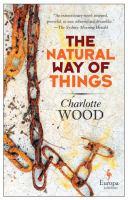
The Natural Way of Things opens dramatically as Yolanda discovers she is being held captive in the Australian Outback. She is one of a small group of women who all have a curious, not immediately obvious, connection: they have all been part of public sex scandals. While the story leaves a lot unanswered and is incredibly dark in content and description, the beautiful writing was enough to keep me engaged until the end.
The story follows Yolanda and another captive, Verla, as they try to navigate survival in the extreme conditions they awoke to after being drugged and kidnapped. They sleep locked up in kennels. They are required to participate in manual labor in the hot summer Outback sun, wearing antiquated canvas and wool clothing with freshly shaved heads. Their food is rationed and mainly consists of bright yellow, very poorly made, powdered macaroni and cheese. Shackled, led on leashes and beaten, the girls are told they are there because they need to know "what they are." Their primary captor is unknown. The only contact they have with those in charge is through the three incompetent guards who were hired to run the camp and do not seem to know much about who is in charge or the true purpose of the camp.
It quickly becomes clear that the young women, who are largely described as having been beautiful, have an idea why they are there, but many also believe they are the exception--like Verla, who believes the man she had a very public affair with will be looking for her, and she pities the other girls who she believes in some way deserve to be there. The "crimes" these young women have committed include being gang-raped by football players, molested by religious leaders and assaulted in industries that predominately employ men. While these women are all kidnapped to pay for their crimes, the men involved in the incidents are free. Upon arrival to the camp, the women are stripped of things that would make them feel beautiful or vain since those appear to be things that led to their crimes and captivity.
Despite the obstacles, the women find a way to survive the deteriorating conditions of the camp. Their trials change them in interesting ways, and the story ends with a symbolic choice between the society that imprisoned them or something else. We are left not knowing what happens to any of the characters, what society is like for those who rejoin, or what the other option might be for those who do not return. The entire story is filled with wonderful metaphors for the incredibly ugly topics of sexism and misogyny in modern times. There is no happy ending in this story, but the writing and the thought-provoking content make this a novel I highly recommend reading.
